Deck 65: Polar Coordinates
Question
Question
Question
Question
Question
Question
Question
Question
Question
Question
Question
Question
Question
Question
Question
Question
Question
Question
Question
Question
Question
Question
Question
Question
Question
Question
Question
Question
Question
Question
Question
Question
Question
Question
Question
Question
Question
Question
Question
Question
Question
Question
Question
Question
Question
Question
Question
Question
Question
Question

Unlock Deck
Sign up to unlock the cards in this deck!
Unlock Deck
Unlock Deck
1/50
Play
Full screen (f)
Deck 65: Polar Coordinates
1
Find the rectangular coordinates of the point given in polar coordinates.Round your results to two decimal places.
A)Rectangular coordinates: (7.61,0.07)
B)Rectangular coordinates: (7.61,-7.61)
C)Rectangular coordinates: (-2.47,-7.61)
D)Rectangular coordinates: (-2.47,7.61)
E)Rectangular coordinates: (-2.47,0.07)
A)Rectangular coordinates: (7.61,0.07)
B)Rectangular coordinates: (7.61,-7.61)
C)Rectangular coordinates: (-2.47,-7.61)
D)Rectangular coordinates: (-2.47,7.61)
E)Rectangular coordinates: (-2.47,0.07)
Rectangular coordinates: (-2.47,-7.61)
2
A point in rectangular coordinates is given.Convert the point to polar coordinates,r > 0.
A)Polar coordinates:
B)Polar coordinates:
C)Polar coordinates:
D)Polar coordinates:
E)Polar coordinates:
A)Polar coordinates:
B)Polar coordinates:
C)Polar coordinates:
D)Polar coordinates:
E)Polar coordinates:
Polar coordinates:
3
A point (a,b)= (r,θ)shown in below graph in polar coordinates is given.Convert the point to rectangular coordinates. 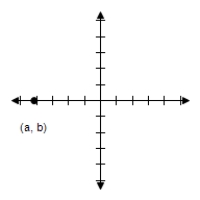
A)Rectangular coordinates: (5,0)
B)Rectangular coordinates: (5,5)
C)Rectangular coordinates: (-5,5)
D)Rectangular coordinates: (-5,0)
E)Rectangular coordinates: (0,5)

A)Rectangular coordinates: (5,0)
B)Rectangular coordinates: (5,5)
C)Rectangular coordinates: (-5,5)
D)Rectangular coordinates: (-5,0)
E)Rectangular coordinates: (0,5)
Rectangular coordinates: (-5,0)
4
Find the rectangular coordinates of the point given in polar coordinates.Round your results to two decimal places.
A)Rectangular coordinates: (3.5,1.62)
B)Rectangular coordinates: (4.50,0.83)
C)Rectangular coordinates: (-0.17,3.50)
D)Rectangular coordinates: (0.83,4.50)
E)Rectangular coordinates: (3.50,-0.17)
A)Rectangular coordinates: (3.5,1.62)
B)Rectangular coordinates: (4.50,0.83)
C)Rectangular coordinates: (-0.17,3.50)
D)Rectangular coordinates: (0.83,4.50)
E)Rectangular coordinates: (3.50,-0.17)

Unlock Deck
Unlock for access to all 50 flashcards in this deck.
Unlock Deck
k this deck
5
Find the rectangular coordinates of the point given in polar coordinates.Round your results to two decimal places.
A)Rectangular coordinates: (2.27,-7.89)
B)Rectangular coordinates: (-7.89,2.27)
C)Rectangular coordinates: (1.27,-8.89)
D)Rectangular coordinates: (-8.89,1.27)
E)Rectangular coordinates: (8.98,4.50)
A)Rectangular coordinates: (2.27,-7.89)
B)Rectangular coordinates: (-7.89,2.27)
C)Rectangular coordinates: (1.27,-8.89)
D)Rectangular coordinates: (-8.89,1.27)
E)Rectangular coordinates: (8.98,4.50)

Unlock Deck
Unlock for access to all 50 flashcards in this deck.
Unlock Deck
k this deck
6
A point in rectangular coordinates is given.Convert the point to polar coordinates,r > 0.
A)Polar coordinates:
B)Polar coordinates:
C)Polar coordinates:
D)Polar coordinates:
E)Polar coordinates:
A)Polar coordinates:
B)Polar coordinates:
C)Polar coordinates:
D)Polar coordinates:
E)Polar coordinates:

Unlock Deck
Unlock for access to all 50 flashcards in this deck.
Unlock Deck
k this deck
7
Find the rectangular coordinates of the point given in polar coordinates.Round your results to two decimal places.
A)Rectangular coordinates: (-3.97,5.09)
B)Rectangular coordinates: (-2.97,5.09)
C)Rectangular coordinates: (-3.97,4.09)
D)Rectangular coordinates: (-2.97,4.09)
E)Rectangular coordinates: (4.09,-3.97)
A)Rectangular coordinates: (-3.97,5.09)
B)Rectangular coordinates: (-2.97,5.09)
C)Rectangular coordinates: (-3.97,4.09)
D)Rectangular coordinates: (-2.97,4.09)
E)Rectangular coordinates: (4.09,-3.97)

Unlock Deck
Unlock for access to all 50 flashcards in this deck.
Unlock Deck
k this deck
8
A point in polar coordinates is given.Convert the point to rectangular coordinates.Round your answers to one decimal places.
A)Rectangular coordinates: (1.9,1.0)
B)Rectangular coordinates: (-1.0,-1.9)
C)Rectangular coordinates: (2.1,1.1)
D)Rectangular coordinates: (-1.9,-1.0)
E)Rectangular coordinates: (1.0,1.9)
A)Rectangular coordinates: (1.9,1.0)
B)Rectangular coordinates: (-1.0,-1.9)
C)Rectangular coordinates: (2.1,1.1)
D)Rectangular coordinates: (-1.9,-1.0)
E)Rectangular coordinates: (1.0,1.9)

Unlock Deck
Unlock for access to all 50 flashcards in this deck.
Unlock Deck
k this deck
9
Find the rectangular coordinates of the point given in polar coordinates.Round your results to two decimal places.
A)Rectangular coordinates: (1.83,-0.81)
B)Rectangular coordinates: (1.83,1.83)
C)Rectangular coordinates: (-0.81,0.81)
D)Rectangular coordinates: (1.83,0.15)
E)Rectangular coordinates: (1.83,0.81)
A)Rectangular coordinates: (1.83,-0.81)
B)Rectangular coordinates: (1.83,1.83)
C)Rectangular coordinates: (-0.81,0.81)
D)Rectangular coordinates: (1.83,0.15)
E)Rectangular coordinates: (1.83,0.81)

Unlock Deck
Unlock for access to all 50 flashcards in this deck.
Unlock Deck
k this deck
10
A point in rectangular coordinates is given.Convert the point to polar coordinates,r > 0.
A)Polar coordinates:
B)Polar coordinates:
C)Polar coordinates:
D)Polar coordinates:
E)Polar coordinates:
A)Polar coordinates:
B)Polar coordinates:
C)Polar coordinates:
D)Polar coordinates:
E)Polar coordinates:

Unlock Deck
Unlock for access to all 50 flashcards in this deck.
Unlock Deck
k this deck
11
A point in rectangular coordinates is given.Convert the point to polar coordinates,r > 0.
A)Polar coordinates:
B)Polar coordinates:
C)Polar coordinates:
D)Polar coordinates:
E)Polar coordinates:
A)Polar coordinates:
B)Polar coordinates:
C)Polar coordinates:
D)Polar coordinates:
E)Polar coordinates:

Unlock Deck
Unlock for access to all 50 flashcards in this deck.
Unlock Deck
k this deck
12
A point in polar coordinates is given.Convert the point to rectangular coordinates.Round your answers to one decimal places.
A)Rectangular coordinates: (3.6,6.0)
B)Rectangular coordinates: (5.5,2.4)
C)Rectangular coordinates: (-5.5,-2.4)
D)Rectangular coordinates: (-2.4,-5.5)
E)Rectangular coordinates: (2.4,5.5)
A)Rectangular coordinates: (3.6,6.0)
B)Rectangular coordinates: (5.5,2.4)
C)Rectangular coordinates: (-5.5,-2.4)
D)Rectangular coordinates: (-2.4,-5.5)
E)Rectangular coordinates: (2.4,5.5)

Unlock Deck
Unlock for access to all 50 flashcards in this deck.
Unlock Deck
k this deck
13
Find the rectangular coordinates of the point given in polar coordinates.Round your results to two decimal places.
A)Rectangular coordinates: (4.89,0.35)
B)Rectangular coordinates: (-4.89,0.35)
C)Rectangular coordinates: (-0.35,4.89)
D)Rectangular coordinates: (0.35,4.89)
E)Rectangular coordinates: (5,1.5)
A)Rectangular coordinates: (4.89,0.35)
B)Rectangular coordinates: (-4.89,0.35)
C)Rectangular coordinates: (-0.35,4.89)
D)Rectangular coordinates: (0.35,4.89)
E)Rectangular coordinates: (5,1.5)

Unlock Deck
Unlock for access to all 50 flashcards in this deck.
Unlock Deck
k this deck
14
Find the rectangular coordinates of the point given in polar coordinates.Round your results to two decimal places.
A)Rectangular coordinates: (-5.03,2.89)
B)Rectangular coordinates: (5.80,2.89)
C)Rectangular coordinates: (2.89,-5.03)
D)Rectangular coordinates: (-4.03,3.89)
E)Rectangular coordinates: (3.89,-4.03)
A)Rectangular coordinates: (-5.03,2.89)
B)Rectangular coordinates: (5.80,2.89)
C)Rectangular coordinates: (2.89,-5.03)
D)Rectangular coordinates: (-4.03,3.89)
E)Rectangular coordinates: (3.89,-4.03)

Unlock Deck
Unlock for access to all 50 flashcards in this deck.
Unlock Deck
k this deck
15
Find the rectangular coordinates of the point given in polar coordinates.Round your results to two decimal places.
A)Rectangular coordinates: (-7.13,-1.02)
B)Rectangular coordinates: (-1.02,-7.13)
C)Rectangular coordinates: (-6.13,-1.02)
D)Rectangular coordinates: (-7.13,-0.02)
E)Rectangular coordinates: (-6.13,-0.02)
A)Rectangular coordinates: (-7.13,-1.02)
B)Rectangular coordinates: (-1.02,-7.13)
C)Rectangular coordinates: (-6.13,-1.02)
D)Rectangular coordinates: (-7.13,-0.02)
E)Rectangular coordinates: (-6.13,-0.02)

Unlock Deck
Unlock for access to all 50 flashcards in this deck.
Unlock Deck
k this deck
16
A point (a,b)shown in below graph in polar coordinates is given.Convert the point to rectangular coordinates. 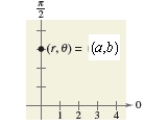
A)Rectangular coordinates: (6,6)
B)Rectangular coordinates: (6,0)
C)Rectangular coordinates: (0,6)
D)Rectangular coordinates: (-6,0)
E)Rectangular coordinates: (0,-6)

A)Rectangular coordinates: (6,6)
B)Rectangular coordinates: (6,0)
C)Rectangular coordinates: (0,6)
D)Rectangular coordinates: (-6,0)
E)Rectangular coordinates: (0,-6)

Unlock Deck
Unlock for access to all 50 flashcards in this deck.
Unlock Deck
k this deck
17
A point in rectangular coordinates is given.Convert the point to polar coordinates,r > 0.
A)Polar coordinates:
B)Polar coordinates:
C)Polar coordinates:
D)Polar coordinates:
E)Polar coordinates:
A)Polar coordinates:
B)Polar coordinates:
C)Polar coordinates:
D)Polar coordinates:
E)Polar coordinates:

Unlock Deck
Unlock for access to all 50 flashcards in this deck.
Unlock Deck
k this deck
18
A point (a,b)shown in below graph in polar coordinates is given.Convert the point to rectangular coordinates. 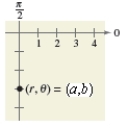
A)Rectangular coordinates: (0,3)
B)Rectangular coordinates: (-3,0)
C)Rectangular coordinates: (3,0)
D)Rectangular coordinates: (0,-3)
E)Rectangular coordinates: (3,3)

A)Rectangular coordinates: (0,3)
B)Rectangular coordinates: (-3,0)
C)Rectangular coordinates: (3,0)
D)Rectangular coordinates: (0,-3)
E)Rectangular coordinates: (3,3)

Unlock Deck
Unlock for access to all 50 flashcards in this deck.
Unlock Deck
k this deck
19
A point in rectangular coordinates is given.Convert the point to polar coordinates,r > 0.
A)Polar coordinates:
B)Polar coordinates:
C)Polar coordinates:
D)Polar coordinates:
E)Polar coordinates:
A)Polar coordinates:
B)Polar coordinates:
C)Polar coordinates:
D)Polar coordinates:
E)Polar coordinates:

Unlock Deck
Unlock for access to all 50 flashcards in this deck.
Unlock Deck
k this deck
20
A point in rectangular coordinates is given.Convert the point to polar coordinates,r > 0.
A)Polar coordinates:
B)Polar coordinates:
C)Polar coordinates:
D)Polar coordinates:
E)Polar coordinates:
A)Polar coordinates:
B)Polar coordinates:
C)Polar coordinates:
D)Polar coordinates:
E)Polar coordinates:

Unlock Deck
Unlock for access to all 50 flashcards in this deck.
Unlock Deck
k this deck
21
Use a graphing utility to find one set of polar coordinates for the point given in rectangular coordinates,r > 0.Round your answers to three decimal places.
A)Polar coordinates:
B)Polar coordinates:
C)Polar coordinates:
D)Polar coordinates:
E)Polar coordinates:
A)Polar coordinates:
B)Polar coordinates:
C)Polar coordinates:
D)Polar coordinates:
E)Polar coordinates:

Unlock Deck
Unlock for access to all 50 flashcards in this deck.
Unlock Deck
k this deck
22
Convert the rectangular equation to polar form.Assume r > 1.
A)
B)
C)
D)
E)
A)
B)
C)
D)
E)

Unlock Deck
Unlock for access to all 50 flashcards in this deck.
Unlock Deck
k this deck
23
Convert the rectangular equation to polar form.Assume a > 0,r > 1.
A)
B)
C)
D)
E)
A)
B)
C)
D)
E)

Unlock Deck
Unlock for access to all 50 flashcards in this deck.
Unlock Deck
k this deck
24
Convert the rectangular equation to polar form.Assume r > 1.
A)
B)
C)
D)
E)
A)
B)
C)
D)
E)

Unlock Deck
Unlock for access to all 50 flashcards in this deck.
Unlock Deck
k this deck
25
Convert the rectangular equation to polar form.Assume a > 0,r > 0.
A)
B)
C)
D)
E)
A)
B)
C)
D)
E)

Unlock Deck
Unlock for access to all 50 flashcards in this deck.
Unlock Deck
k this deck
26
Convert the rectangular equation to polar form.Assume r > 1.
A)
B)
C)
D)
E)
A)
B)
C)
D)
E)

Unlock Deck
Unlock for access to all 50 flashcards in this deck.
Unlock Deck
k this deck
27
Convert the rectangular equation to polar form.Assume r > 1.
A)
B)
C)
D)
E)
A)
B)
C)
D)
E)

Unlock Deck
Unlock for access to all 50 flashcards in this deck.
Unlock Deck
k this deck
28
A point in rectangular coordinates is given.Convert the point to polar coordinates,r > 0.
A)Polar coordinates:
B)Polar coordinates:
C)Polar coordinates:
D)Polar coordinates:
E)Polar coordinates:
A)Polar coordinates:
B)Polar coordinates:
C)Polar coordinates:
D)Polar coordinates:
E)Polar coordinates:

Unlock Deck
Unlock for access to all 50 flashcards in this deck.
Unlock Deck
k this deck
29
Convert the rectangular equation to polar form.Assume r > 1.
A)
B)
C)
D)
E)
A)
B)
C)
D)
E)

Unlock Deck
Unlock for access to all 50 flashcards in this deck.
Unlock Deck
k this deck
30
Convert the rectangular equation to polar form.Assume r > 1.
A)
B)
C)
D)
E)
A)
B)
C)
D)
E)

Unlock Deck
Unlock for access to all 50 flashcards in this deck.
Unlock Deck
k this deck
31
Convert the rectangular equation to polar form.Assume r > 1.
A)
B)
C)
D)
E)
A)
B)
C)
D)
E)

Unlock Deck
Unlock for access to all 50 flashcards in this deck.
Unlock Deck
k this deck
32
Convert the rectangular equation to polar form.Assume r > 1.
A)
B)
C)
D)
E)
A)
B)
C)
D)
E)

Unlock Deck
Unlock for access to all 50 flashcards in this deck.
Unlock Deck
k this deck
33
Convert the polar equation to rectangular form.
A)
B)
C)
D)
E)
A)
B)
C)
D)
E)

Unlock Deck
Unlock for access to all 50 flashcards in this deck.
Unlock Deck
k this deck
34
Convert the rectangular equation to polar form.Assume a > 0,r > 1.
A)
B)
C)
D)
E)
A)
B)
C)
D)
E)

Unlock Deck
Unlock for access to all 50 flashcards in this deck.
Unlock Deck
k this deck
35
Convert the rectangular equation to polar form.Assume r > 1.
A)
B)
C)
D)
E)
A)
B)
C)
D)
E)

Unlock Deck
Unlock for access to all 50 flashcards in this deck.
Unlock Deck
k this deck
36
A point in rectangular coordinates is given.Convert the point to polar coordinates.Round your answers to two decimal places,r > 0.
A)Polar coordinates:
B)Polar coordinates:
C)Polar coordinates:
D)Polar coordinates:
E)Polar coordinates:
A)Polar coordinates:
B)Polar coordinates:
C)Polar coordinates:
D)Polar coordinates:
E)Polar coordinates:

Unlock Deck
Unlock for access to all 50 flashcards in this deck.
Unlock Deck
k this deck
37
A point in rectangular coordinates is given.Convert the point to polar coordinates,r > 0.
A)Polar coordinates:
B)Polar coordinates:
C)Polar coordinates:
D)Polar coordinates:
E)Polar coordinates:
A)Polar coordinates:
B)Polar coordinates:
C)Polar coordinates:
D)Polar coordinates:
E)Polar coordinates:

Unlock Deck
Unlock for access to all 50 flashcards in this deck.
Unlock Deck
k this deck
38
Convert the polar equation to rectangular form.
A)
B)
C)
D)
E)
A)
B)
C)
D)
E)

Unlock Deck
Unlock for access to all 50 flashcards in this deck.
Unlock Deck
k this deck
39
Convert the polar equation to rectangular form.
A)
B)
C)
D)
E)
A)
B)
C)
D)
E)

Unlock Deck
Unlock for access to all 50 flashcards in this deck.
Unlock Deck
k this deck
40
Convert the rectangular equation to polar form.Assume r > 1.
A)
B)
C)
D)
E)
A)
B)
C)
D)
E)

Unlock Deck
Unlock for access to all 50 flashcards in this deck.
Unlock Deck
k this deck
41
Describe the graph of the polar equation and find the corresponding rectangular equation.Select the correct graph.
A)The graph of the polar equation is not evident by simple inspection.Convert to rectangular form first. 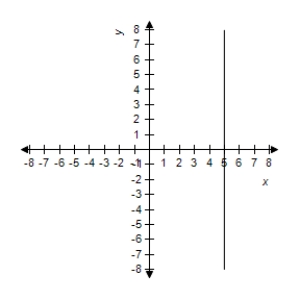
B)The graph of the polar equation is not evident by simple inspection.Convert to rectangular form first. 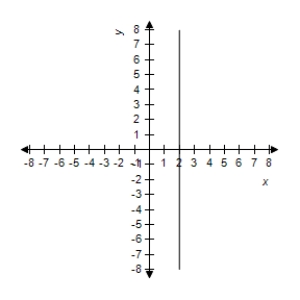
C)The graph of the polar equation is not evident by simple inspection.Convert to rectangular form first. 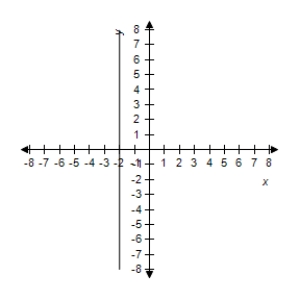
D)The graph of the polar equation is not evident by simple inspection.Convert to rectangular form first.
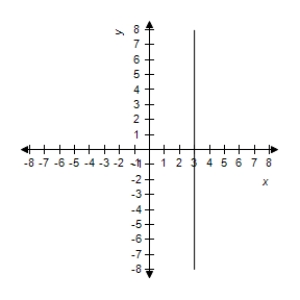
E)The graph of the polar equation is not evident by simple inspection.Convert to rectangular form first. 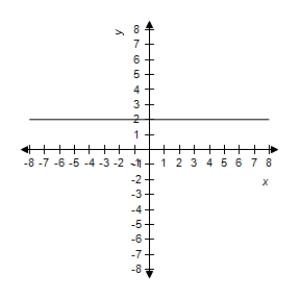
A)The graph of the polar equation is not evident by simple inspection.Convert to rectangular form first.

B)The graph of the polar equation is not evident by simple inspection.Convert to rectangular form first.

C)The graph of the polar equation is not evident by simple inspection.Convert to rectangular form first.

D)The graph of the polar equation is not evident by simple inspection.Convert to rectangular form first.

E)The graph of the polar equation is not evident by simple inspection.Convert to rectangular form first.


Unlock Deck
Unlock for access to all 50 flashcards in this deck.
Unlock Deck
k this deck
42
Convert the polar equation to rectangular form.
A)
B)
C)
D)
E)
A)
B)
C)
D)
E)

Unlock Deck
Unlock for access to all 50 flashcards in this deck.
Unlock Deck
k this deck
43
Convert the polar equation to rectangular form.
A)
B)
C)
D)
E)
A)
B)
C)
D)
E)

Unlock Deck
Unlock for access to all 50 flashcards in this deck.
Unlock Deck
k this deck
44
Describe the graph of the polar equation and find the corresponding rectangular equation.Select the correct graph.
A)The graph of the polar equation consists of all points that are two units from the pole.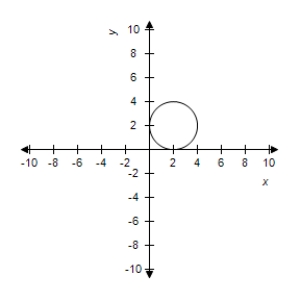
B)The graph of the polar equation consists of all points that are two units from the pole.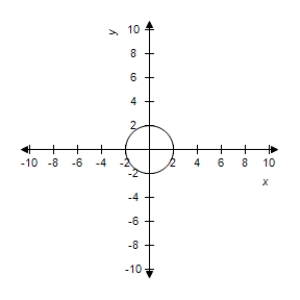
C)The graph of the polar equation consists of all points that are two units from the pole.
D)The graph of the polar equation consists of all points that are two units from the pole.
E)The graph of the polar equation consists of all points that are two units from the pole.
A)The graph of the polar equation consists of all points that are two units from the pole.

B)The graph of the polar equation consists of all points that are two units from the pole.

C)The graph of the polar equation consists of all points that are two units from the pole.

D)The graph of the polar equation consists of all points that are two units from the pole.

E)The graph of the polar equation consists of all points that are two units from the pole.


Unlock Deck
Unlock for access to all 50 flashcards in this deck.
Unlock Deck
k this deck
45
Convert the polar equation to rectangular form.
A)
B)
C)
D)
E)
A)
B)
C)
D)
E)

Unlock Deck
Unlock for access to all 50 flashcards in this deck.
Unlock Deck
k this deck
46
Describe the graph of the polar equation and find the corresponding rectangular equation.Select the correct graph.
A)The graph of the polar equation is not evident by simple inspection.Convert to rectangular form first. 
B)The graph of the polar equation is not evident by simple inspection.Convert to rectangular form first. 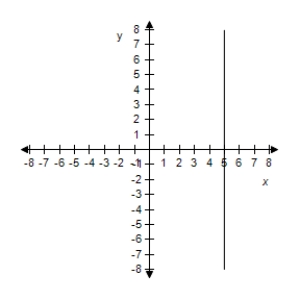
C)The graph of the polar equation is not evident by simple inspection.Convert to rectangular form first. 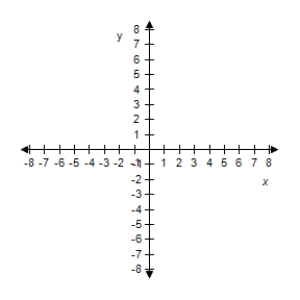
D)The graph of the polar equation is not evident by simple inspection.Convert to rectangular form first. 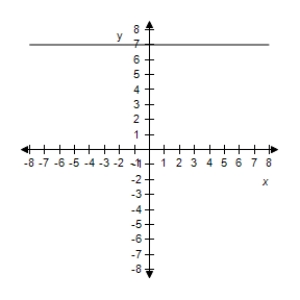
E)The graph of the polar equation is not evident by simple inspection.Convert to rectangular form first. 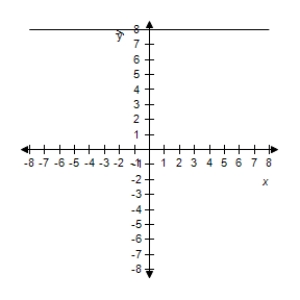
A)The graph of the polar equation is not evident by simple inspection.Convert to rectangular form first.

B)The graph of the polar equation is not evident by simple inspection.Convert to rectangular form first.

C)The graph of the polar equation is not evident by simple inspection.Convert to rectangular form first.

D)The graph of the polar equation is not evident by simple inspection.Convert to rectangular form first.

E)The graph of the polar equation is not evident by simple inspection.Convert to rectangular form first.


Unlock Deck
Unlock for access to all 50 flashcards in this deck.
Unlock Deck
k this deck
47
Convert the polar equation to rectangular form.
A)
B)
C)
D)
E)
A)
B)
C)
D)
E)

Unlock Deck
Unlock for access to all 50 flashcards in this deck.
Unlock Deck
k this deck
48
Convert the polar equation to rectangular form.
A)
B)
C)
D)
E)
A)
B)
C)
D)
E)

Unlock Deck
Unlock for access to all 50 flashcards in this deck.
Unlock Deck
k this deck
49
Convert the polar equation to rectangular form.
A)
B)
C)
D)
E)
A)
B)
C)
D)
E)

Unlock Deck
Unlock for access to all 50 flashcards in this deck.
Unlock Deck
k this deck
50
Convert the polar equation to rectangular form.
A)
B)
C)
D)
E)
A)
B)
C)
D)
E)

Unlock Deck
Unlock for access to all 50 flashcards in this deck.
Unlock Deck
k this deck



